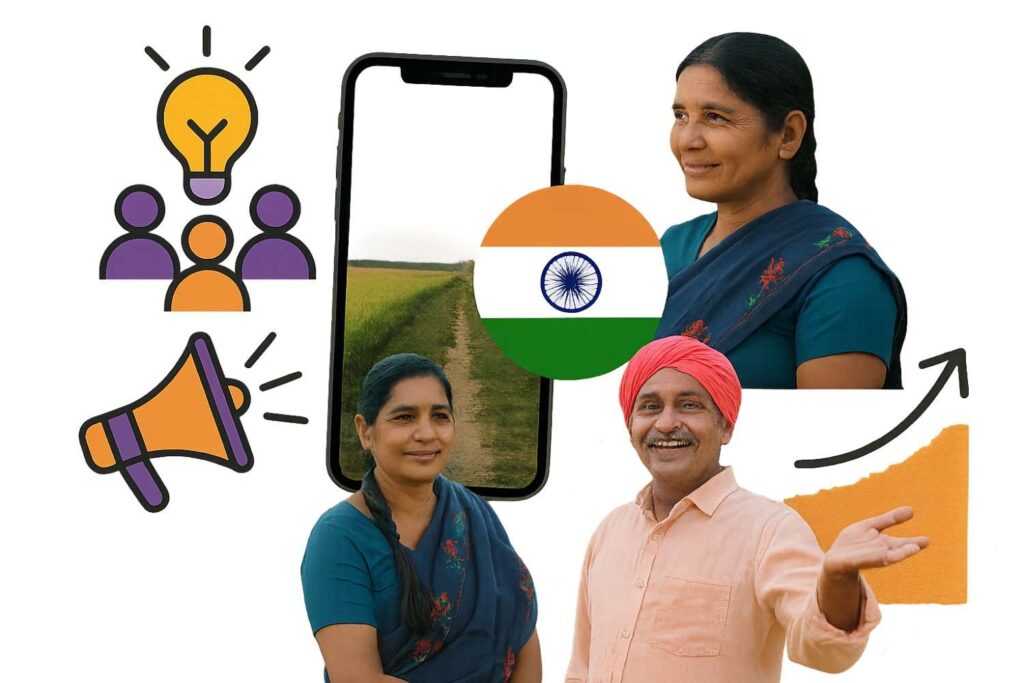Table Of Content
- The Wisdom of Stories and Seeds
- Understanding the Indian Heartland Buyer
- Authentic Messaging: The Core of Trust
- Crafting Your Brand Story: The 5 Key Elements
- 1. Origin Story: Where It All Began
- 2. Purpose & Values: The Heartbeat
- 3. Unique Craftsmanship: The Artisan’s Touch
- 4. Customer Connection: Their Story, Your Story
- 5. Future Vision: Inviting Participation
- Using Cultural Cues to Deepen Connection
- Storytelling Formats That Work Online
- 1. Short Videos & Reels
- 2. Photo Stories & Behind-the-Scenes Content
- 3. Testimonials & Customer Stories
- 4. Cultural & Festival Campaigns
- 5. Live Sharing & Interactive Sessions
- Optimizing for Google & SEO
- Conclusion
- Frequently Asked Questions (FAQs)
- What can I find on Webverbal?
- How often is the content updated?
- Why choose Webverbal for information?
The Wisdom of Stories and Seeds
As the ancient saying goes, “A tree is known by its fruit,” and another proverb reminds us, “The roots of a tree hold it firm against the storm.” In the vast and vibrant marketplaces of India’s heartland, these words hold a timeless truth for every artisan and entrepreneur.
With over 11 years of experience as an e-commerce founder and a mentor for change with Niti Aayog, I have closely witnessed how powerful brand stories rooted in authenticity and culture can transform small businesses from tier 2 and 3 towns into trusted names across India. Market research consistently shows that Indian heartland buyers value emotional connection, tradition, and trust—qualities that only genuine storytelling can deliver.
Building a strong brand story is like planting a seed in fertile soil—it brings forth fruit that feeds not just the body, but also the soul of customers. For rural artisans and small-town sellers, your story is the root—deep in tradition, culture, and values—that anchors the trust of your buyers.
Consider Radha, a potter from a tier 3 town who once struggled to sell beyond her village boundaries. It was when she began sharing her authentic journey—the challenges, joys, and meaning behind every pot—that her small business blossomed, reaching homes far beyond the dusty lanes she called home.
In today’s digital and competitive world, a powerful brand story acts as your voice amid the noise. It is the bridge that connects your craft to customers’ hearts, especially in the Indian heartland, where buyers seek not just products, but meaning and trust behind them.
Understanding the Indian Heartland Buyer

To build a brand story that truly connects, it’s essential to first understand the heartland buyer’s mindset. The Indian heartland primarily includes tier 2 and tier 3 towns and rural areas where tradition, family values, and community play a central role in daily life.
Buyers here are deeply rooted in culture. They value products that resonate with their identity, heritage, and aspirations. Trust is more than a business term—it’s a lived experience handed down through generations, often based on word of mouth and personal relationships.
From my years of mentoring startups and engaging with small-town sellers, I’ve learned that heartland buyers appreciate brands that speak their language—not just linguistically but culturally. They look for brands that reflect their festivals, rituals, and even local proverbs. For example, during Diwali, a handcrafted diya or a Rangoli kit that tells a story of tradition can find a more receptive audience than generic products.
Another core aspect is the desire for authenticity and transparency. These buyers often prefer handcrafted, locally sourced goods that connect with the values of sustainability and heritage. They expect sellers to not just sell a product but share the story of its making, the people behind it, and the care involved.
Understanding these cultural cues and integrating them into your brand story isn’t just an option—it’s a necessity for creating a meaningful connection with your audience.
Authentic Messaging: The Core of Trust
In my experience building and mentoring e-commerce brands, especially those rooted in tier 2 and 3 towns, authenticity isn’t just a buzzword—it’s the heartbeat of sustainable success. For Indian heartland buyers, authenticity transforms a simple product into a legacy they can trust and pass on.
Authentic messaging means sharing your real story—your journey, your challenges, your values—in a way that resonates deeply with your audience’s culture and emotions. It’s about being transparent, honest, and relatable.
For instance, instead of just saying “Handmade pottery,” a brand might say, “Each of our pots is lovingly crafted by Radha, using clay from the nearby riverbed, just as her ancestors did, preserving traditions that date back centuries.” Such messaging does three things: it humanizes the brand, creates cultural relevance, and conveys care.
Language is a powerful vehicle here. Using local dialects, idioms, and cultural references can greatly enhance relatability. For example, incorporating local festival greetings or proverbs like “Mehnat rang laati hai” (Hard work bears fruit) in your messaging subtly echoes the values your audience holds dear.
Authentic messaging also extends to visuals. Photographs and videos depicting artisans at work, snippets of their daily lives, and behind-the-scenes glimpses make your story tangible and trustworthy. Customers aren’t just buying a product—they are buying into a trusted community and heritage.
Data and market insights support this: studies show that consumers from these regions prioritize brands that feel “like one of us” over global luxury brands that lack relatable narratives. This emotional proximity is invaluable.
As you craft your brand story, remember: authenticity is the bridge between tradition and modernity that Indian heartland buyers walk daily. It builds trust that no discount or flashy ad can replace.
Read more: Consumer Behaviour in Tier 2/3 India
Crafting Your Brand Story: The 5 Key Elements
Successfully connecting with Indian heartland buyers through your brand story involves weaving together five essential elements. These form the backbone of narratives that inspire trust, loyalty, and pride.
1. Origin Story: Where It All Began
Every brand has a beginning, often rooted in tradition, passion, or a challenge. Share it honestly and vividly. For example, an artisan might tell how their ancestors crafted pottery along a river, or how a desire to create sustainable products sparked their journey. Origin stories ground your brand in heritage and make it relatable.
Example: “My journey began in my grandmother’s courtyard, learning the art of weaving from threads that tell stories of our village.”
2. Purpose & Values: The Heartbeat
Why do you do what you do? What drives your passion beyond profits? Indian heartland buyers connect deeply with brands that stand for something meaningful—be it preserving culture, empowering local communities, or promoting eco-friendly crafts. This sense of purpose makes your brand a cause, not just a product.
Example: “We believe in keeping traditions alive while providing sustainable livelihoods to our artisans.”
3. Unique Craftsmanship: The Artisan’s Touch
Highlight the uniqueness in your product—be it handmade techniques, choice of raw materials, or intricate detailing. This not only differentiates you but also elevates value in customers’ eyes. Use sensory and emotional language to bring craftsmanship alive.
Example: “Each piece is spun on a traditional wheel, shaped by hand, and baked under the sun, with slight variations making every pot uniquely yours.”
4. Customer Connection: Their Story, Your Story
Show how your product becomes part of your customer’s life—the festivals it shines in, the homes it beautifies, the gifts it carries. This transcends transactional buying and builds emotional bonds.
Example: “Our lamps light up Diwali celebrations in thousands of homes; they’re not just pots, but carriers of joy and togetherness.”
5. Future Vision: Inviting Participation
Share where your brand is headed and invite your customers on this journey. This openness fosters community and long-term loyalty. It shows you’re evolving, yet anchored in your core values.
Example: “Together, we’re creating a future where age-old crafts thrive alongside innovation, making every customer a guardian of heritage.”
For proven strategies, see How to build a great brand story by Harvard Business Review.
Using Cultural Cues to Deepen Connection
In India’s diverse heartland, culture is the invisible thread that ties communities together. As an artisan or seller, weaving cultural cues into your brand story elevates your connection with buyers beyond products—it touches their identity and pride.
Cultural cues include festivals, local legends, traditional symbols, and regional rituals. For example, during Sankranti, a brand selling handmade pottery might highlight how their products are perfect for serving festive sweets, using imagery and language that echo local warmth and celebration.
Respect and celebration of local customs show buyers that your brand is one with their community, not a distant outsider. This builds an unspoken trust and loyalty that data alone can’t capture.
From my experience mentoring startups, brands that authentically embrace local culture in their storytelling see higher engagement and repeat customer rates. A case in point is an artisanal textile brand from Madhya Pradesh that tied its online campaigns with traditional tribal art motifs and festival greetings, creating a surge in emotional connection and sales during cultural seasons.
Integrating cultural cues also involves sensitivity—avoid clichés or stereotypes, and instead celebrate true stories from your roots. This authenticity resonates deeply and sets you apart.
Using cultural symbols in your packaging, social media content, and product descriptions adds layers of meaning that heartland buyers cherish.
Storytelling Formats That Work Online
In a world flooded with images and messages, the way you tell your story matters just as much as the story itself. For rural artisans and small-town sellers, using simple, genuine formats makes your story accessible, engaging, and memorable.
1. Short Videos & Reels
Videos are powerful because they combine visuals, sound, and emotion. Show artisans at work, tell snippets of their stories, or capture festival moments. A short video of Radha shaping her pots, accompanied by her voice sharing her heritage, will resonate far more than words alone.
2. Photo Stories & Behind-the-Scenes Content
Share images of the crafting process, local landscapes, or the artisan’s daily life—creating a visual journey that brings authenticity to your brand. Use captions in local language where possible to deepen relatability.
3. Testimonials & Customer Stories
User-generated content like photos and reviews from satisfied buyers act as social proof. When customers share how your product adds value to their festivals or daily life, it builds trust in new buyers.
4. Cultural & Festival Campaigns
Tie your storytelling to local festivals, rituals, and legends. For example, create a campaign around Diwali, sharing stories of how your products are part of the celebrations, using festival-specific language and imagery.
5. Live Sharing & Interactive Sessions
Live chats with artisans or Q&A sessions about the craft create transparency. Audience can ask questions, see the process live, and connect emotionally—building trust and a sense of community.
Optimizing for Google & SEO
Use keywords naturally within your stories: “Handmade craft from ,” “Authentic Indian artisan story,” and “Traditional craft online India.”
Incorporate relevant images, descriptive alt texts, and captions. Content that combines rich storytelling with SEO best practices will rank higher and reach more hearts.
Conclusion
Building a strong brand story rooted in authenticity, culture, and emotional connection is no longer optional—it’s essential for rural and small-town artisans who want to succeed in India’s evolving digital marketplace. A powerful story builds trust, loyalty, and community, transforming customers into lifelong supporters.
Start today: share your origin, your values, your craftsmanship, and invite your customers to join you on this journey. As the proverb goes, “Be the tree that bends with the wind, yet stands firm in the storm.” Your brand story is your strongest root.
Frequently Asked Questions (FAQs)
A: A compelling brand story builds emotional connection and trust, which are crucial for Indian heartland customers who value tradition and authenticity.
A: Incorporating local festivals, proverbs, and customs into your story makes your brand relatable and builds community trust.
A: Short videos, photo stories, customer testimonials, festival campaigns, and live sessions work well to engage heartland buyers.
A: Use localized keywords, optimize metadata, add alt text to images, and encourage user-generated content to improve search visibility.
A: Origin story, purpose & values, unique craftsmanship, customer connection, and future vision create a meaningful narrative.




